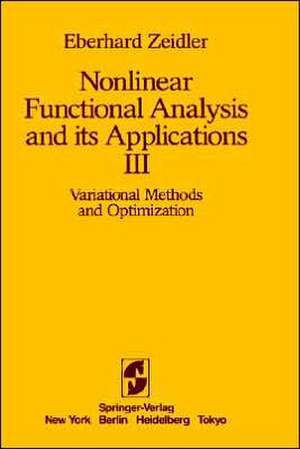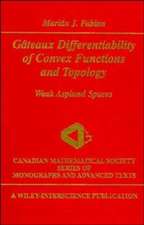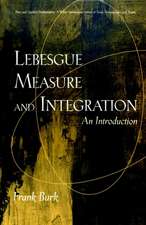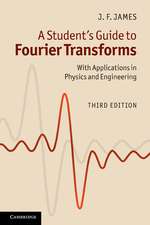Nonlinear Functional Analysis and its Applications: III: Variational Methods and Optimization
Autor E. Zeidler Traducere de L.F. Boronen Limba Engleză Hardback – 27 noi 1984
| Toate formatele și edițiile | Preț | Express |
|---|---|---|
| Paperback (4) | 659.53 lei 6-8 săpt. | |
| Springer – 18 dec 2013 | 659.53 lei 6-8 săpt. | |
| Springer – 3 oct 2012 | 953.52 lei 6-8 săpt. | |
| Springer – 14 noi 2013 | 1568.63 lei 6-8 săpt. | |
| Springer – 27 noi 2013 | 1691.18 lei 6-8 săpt. | |
| Hardback (4) | 914.83 lei 6-8 săpt. | |
| Springer – 27 noi 1984 | 914.83 lei 6-8 săpt. | |
| Springer – 10 dec 1989 | 959.98 lei 6-8 săpt. | |
| Springer – 11 dec 1989 | 1623.30 lei 6-8 săpt. | |
| Springer – apr 1997 | 1701.76 lei 6-8 săpt. |
Preț: 914.83 lei
Preț vechi: 1115.65 lei
-18% Nou
Puncte Express: 1372
Preț estimativ în valută:
175.05€ • 182.41$ • 144.94£
175.05€ • 182.41$ • 144.94£
Carte tipărită la comandă
Livrare economică 03-17 aprilie
Preluare comenzi: 021 569.72.76
Specificații
ISBN-13: 9780387909158
ISBN-10: 038790915X
Pagini: 662
Ilustrații: XXII, 662 p.
Dimensiuni: 156 x 234 x 37 mm
Greutate: 1.13 kg
Ediția:1985
Editura: Springer
Colecția Springer
Locul publicării:New York, NY, United States
ISBN-10: 038790915X
Pagini: 662
Ilustrații: XXII, 662 p.
Dimensiuni: 156 x 234 x 37 mm
Greutate: 1.13 kg
Ediția:1985
Editura: Springer
Colecția Springer
Locul publicării:New York, NY, United States
Public țintă
GraduateCuprins
to the Subject.- 18 Variational Problems, the Ritz Method, and the Idea of Orthogonality.- §18.1. The Space C0?(G) and the Variational Lemma.- §18.2. Integration by Parts.- §18.3. The First Boundary Value Problem and the Ritz Method.- §18.4. The Second and Third Boundary Value Problems and the Ritz Method.- §18.5. Eigenvalue Problems and the Ritz Method.- §18.6. The Hölder Inequality and its Applications.- §18.7. The History of the Dirichlet Principle and Monotone Operators.- §18.8. The Main Theorem on Quadratic Minimum Problems.- §18.9. The Inequality of Poincaré-Friedrichs.- §18.10. The Functional Analytic Justification of the Dirichlet Principle.- §18.11. The Perpendicular Principle, the Riesz Theorem, and the Main Theorem on Linear Monotone Operators.- §18.12. The Extension Principle and the Completion Principle.- §18.13. Proper Subregions.- §18.14. The Smoothing Principle.- §18.15. The Idea of the Regularity of Generalized Solutions and the Lemma of Weyl.- §18.16. The Localization Principle.- §18.17. Convex Variational Problems, Elliptic Differential Equations, and Monotonicity.- §18.18. The General Euler-Lagrange Equations.- §18.19. The Historical Development of the 19th and 20th Problems of Hilbert and Monotone Operators.- §18.20. Sufficient Conditions for Local and Global Minima and Locally Monotone Operators.- 19 The Galerkin Method for Differential and Integral Equations, the Friedrichs Extension, and the Idea of Self-Adjointness.- §19.1. Elliptic Differential Equations and the Galerkin Method.- §19.2. Parabolic Differential Equations and the Galerkin Method.- §19.3. Hyperbolic Differential Equations and the Galerkin Method.- §19.4. Integral Equations and the Galerkin Method.- §19.5. Complete Orthonormal Systems and Abstract Fourier Series.- §19.6. Eigenvalues of Compact Symmetric Operators (Hilbert-Schmidt Theory).- §19.7. Proof of Theorem 19.B.- §19.8. Self-Adjoint Operators.- §19.9. The Friedrichs Extension of Symmetric Operators.- §19.10. Proof of Theorem 19.C.- §19.11. Application to the Poisson Equation.- §19.12. Application to the Eigenvalue Problem for the Laplace Equation.- §19.13. The Inequality of Poincaré and the Compactness Theorem of Rellich.- §19.14. Functions of Self-Adjoint Operators.- §19.15. Application to the Heat Equation.- §19.16. Application to the Wave Equation.- §19.17. Semigroups and Propagators, and Their Physical Relevance.- §19.18. Main Theorem on Abstract Linear Parabolic Equations.- §19.19. Proof of Theorem 19.D.- §19.20. Monotone Operators and the Main Theorem on Linear Nonexpansive Semigroups.- §19.21. The Main Theorem on One-Parameter Unitary Groups.- §19.22. Proof of Theorem 19.E.- §19.23. Abstract Semilinear Hyperbolic Equations.- §19.24. Application to Semilinear Wave Equations.- §19.25. The Semilinear Schrödinger Equation.- §19.26. Abstract Semilinear Parabolic Equations, Fractional Powers of Operators, and Abstract Sobolev Spaces.- §19.27. Application to Semilinear Parabolic Equations.- §19.28. Proof of Theorem 19.I.- §19.29. Five General Uniqueness Principles and Monotone Operators.- §19.30. A General Existence Principle and Linear Monotone Operators.- 20 Difference Methods and Stability.- §20.1. Consistency, Stability, and Convergence.- §20.2. Approximation of Differential Quotients.- §20.3. Application to Boundary Value Problems for Ordinary Differential Equations.- §20.4. Application to Parabolic Differential Equations.- §20.5. Application to Elliptic Differential Equations.- §20.6. The Equivalence Between Stability and Convergence.- §20.7. The Equivalence Theorem of Lax for Evolution Equations.- Linear Monotone Problems.- 21 Auxiliary Tools and the Convergence of the Galerkin Method for Linear Operator Equations.- §21.1. Generalized Derivatives.- §21.2. Sobolev Spaces.- §21.3. The Sobolev Embedding Theorems.- §21.4. Proof of the Sobolev Embedding Theorems.- §21.5. Duality in B-Spaces.- §21.6. Duality in H-Spaces.- §21.7. The Idea of Weak Convergence.- §21.8. The Idea of Weak* Convergence.- §21.9. Linear Operators.- §21.10. Bilinear Forms.- §21.11. Application to Embeddings.- §21.12. Projection Operators.- §21.13. Bases and Galerkin Schemes.- §21.14. Application to Finite Elements.- §21.15. Riesz-Schauder Theory and Abstract Fredholm Alternatives.- §21.16. The Main Theorem on the Approximation-Solvability of Linear Operator Equations, and the Convergence of the Galerkin Method.- §21.17. Interpolation Inequalities and a Convergence Trick.- §21.18. Application to the Refined Banach Fixed-Point Theorem and the Convergence of Iteration Methods.- §21.19. The Gagliardo-Nirenberg Inequalities.- §21.20. The Strategy of the Fourier Transform for Sobolev Spaces.- §21.21. Banach Algebras and Sobolev Spaces.- §21.22. Moser-Type Calculus Inequalities.- §21.23. Weakly Sequentially Continuous Nonlinear Operators on Sobolev Spaces.- 22 Hilbert Space Methods and Linear Elliptic Differential Equations.- §22.1. Main Theorem on Quadratic Minimum Problems and the Ritz Method.- §22.2. Application to Boundary Value Problems.- §22.3. The Method of Orthogonal Projection, Duality, and a posteriori Error Estimates for the Ritz Method.- §22.4. Application to Boundary Value Problems.- §22.5. Main Theorem on Linear Strongly Monotone Operators and the Galerkin Method.- §22.6. Application to Boundary Value Problems.- §22.7. Compact Perturbations of Strongly Monotone Operators, Fredholm Alternatives, and the Galerkin Method.- §22.8. Application to Integral Equations.- §22.9. Application to Bilinear Forms.- §22.10. Application to Boundary Value Problems.- §22.11. Eigenvalue Problems and the Ritz Method.- §22.12. Application to Bilinear Forms.- §22.13. Application to Boundary-Eigenvalue Problems.- §22.14. Gårding Forms.- §22.15. The Gårding Inequality for Elliptic Equations.- §22.16. The Main Theorems on Gårding Forms.- §22.17. Application to Strongly Elliptic Differential Equations of Order 2m.- §22.18. Difference Approximations.- §22.19. Interior Regularity of Generalized Solutions.- §22.20. Proof of Theorem 22.H.- §22.21. Regularity of Generalized Solutions up to the Boundary.- §22.22. Proof of Theorem 22.I.- 23 Hilbert Space Methods and Linear Parabolic Differential Equations.- §23.1. Particularities in the Treatment of Parabolic Equations.- §23.2. The Lebesgue Space Lp(0, T; X) of Vector-Valued Functions.- §23.3. The Dual Space to Lp(0, T; X).- §23.4. Evolution Triples.- §23.5. Generalized Derivatives.- §23.6. The Sobolev Space WP1 (0, T; V, H).- §23.7. Main Theorem on First-Order Linear Evolution Equations and the Galerkin Method.- §23.8. Application to Parabolic Differential Equations.- §23.9. Proof of the Main Theorem.- 24 Hilbert Space Methods and Linear Hyperbolic Differential Equations.- §24.1. Main Theorem on Second-Order Linear Evolution Equations and the Galerkin Method.- §24.2. Application to Hyperbolic Differential Equations.- §24.3. Proof of the Main Theorem.
Descriere
Descriere de la o altă ediție sau format:
The main concern in all scientific work must be the human being himsel[ This, one should never forget among all those diagrams and equations. Albert Einstein This volume is part of a comprehensive presentation of nonlinear functional analysis, the basic content of which has been outlined in the Preface of Part I. A Table of Contents for all five volumes may also be found in Part I. The Part IV and the following Part V contain applications to mathematical present physics. Our goals are the following: (i) A detailed motivation of the basic equations in important disciplines of theoretical physics. (ii) A discussion of particular problems which have played a significant role in the development of physics, and through which important mathe matical and physical insight may be gained. (iii) A combination of classical and modern ideas. (iv) An attempt to build a bridge between the language and thoughts of physicists and mathematicians. Weshall always try to advance as soon as possible to the heart ofthe problern under consideration and to concentrate on the basic ideas.
The main concern in all scientific work must be the human being himsel[ This, one should never forget among all those diagrams and equations. Albert Einstein This volume is part of a comprehensive presentation of nonlinear functional analysis, the basic content of which has been outlined in the Preface of Part I. A Table of Contents for all five volumes may also be found in Part I. The Part IV and the following Part V contain applications to mathematical present physics. Our goals are the following: (i) A detailed motivation of the basic equations in important disciplines of theoretical physics. (ii) A discussion of particular problems which have played a significant role in the development of physics, and through which important mathe matical and physical insight may be gained. (iii) A combination of classical and modern ideas. (iv) An attempt to build a bridge between the language and thoughts of physicists and mathematicians. Weshall always try to advance as soon as possible to the heart ofthe problern under consideration and to concentrate on the basic ideas.




























